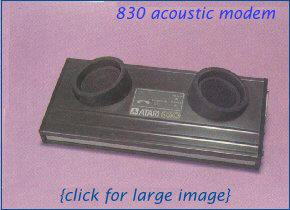IBM's,
Commodores or Apple machines at the time were bulky, expensive
and/or not designed for home use. Like the consoles Atari started
something new and exciting.
![]() --This
page is under construction--
--This
page is under construction--
last update--April 200
"Home
computers" were rare in 1979, computers were considered as complex, confusing machines by most people, and not worth paying thousands of dollars to use at home. Atari released a new home computer designed powerful yet easy to use and understand, yet affordable and expandable to suit all technical applications, from electronic filing to programming to entertainment
IBM's,
Commodores or Apple machines at the time were bulky, expensive
and/or not designed for home use. Like the consoles Atari started
something new and exciting.
![]() --This
page is under construction--
--This
page is under construction--
last update--April 200
Atari 400
![]() The 400 arrived first. An impressive collection of custom audio and video processors built around a 6502 CPU. Priced affordable for home buyers and uses a television for display, giving a readable 40x24 columns of text in standard text mode. Atari added other modes for enhanced text and graphics in the hardware for easier programming. It also produced sound through four independent channels from the TV speakers. There were all necessary cables included.
The 400 arrived first. An impressive collection of custom audio and video processors built around a 6502 CPU. Priced affordable for home buyers and uses a television for display, giving a readable 40x24 columns of text in standard text mode. Atari added other modes for enhanced text and graphics in the hardware for easier programming. It also produced sound through four independent channels from the TV speakers. There were all necessary cables included.
The function keys are
(top-to-bottom):
System Reset , Option , Select , Start
Soon after the 800 shipped with
a full-stroke keyboard for faster typing, it also had twin
cartridge ports and expanded RAM - up to 48k. It also has an
additional port for a high-res monitor. memory cards
image
The keyboard layout is identical on both. (click on image for
larger view)
Each model offers a recorder/disk drive I/O port, and
television hookups on the back with built-in RF shielding. Four controller ports on the
front (the same 9-pin plug used on Atari's 2600) were also included.
»With these came peripherals
for file storage, communications and printing.
Atari 410
![]()
The program recorder was the first permanent file storage method.
Atari shipped the 410 for use with the 400/800 computers [you
cannot use a regular cassette recorder]. Atari BASIC offered easy
access to cassette storage. Atari program recorders could record
sound and programs on the same tape.
Atari 810
![]()
The 810 was a
single-sided single-density disk drive with 88K per 5¼"
disk storage capacity. DOS II made file handling easy and BASIC
had some commands for store/retrieve files. It was somewhat noisy
but fairy reliable. You could daisy-chain up to 4 drives on one
computer, with other peripherals at the end.
Atari telecommunications
The Atari 850 interface
module allowed any manufacturers modem to be used on the Atari
computers, including Atari's own 830, an acoustic modem.
Atari later released a newer model which did not need the 850,
since in plugged in directly, named the Atari 835.


Atari printers
There was several printers marketed under the Atari name. The first Atari printers were the Model 820, 822, and 825 . The Atari 822 is a thermal printer which had low quality. The 820 dot matrix printer lacked graphics abilities and was replaced by the 825 printer (image)
Atari CX85
![]()
An optional numeric keypad for any Atari computer. It has a
standard 10-key adding maching configuration, with raised dot on
the 5 key. All 4 function keys are redefinable under program
control (overlay included)
MicroSoft software from long before WINDOWS